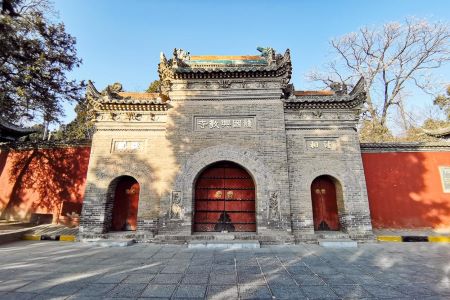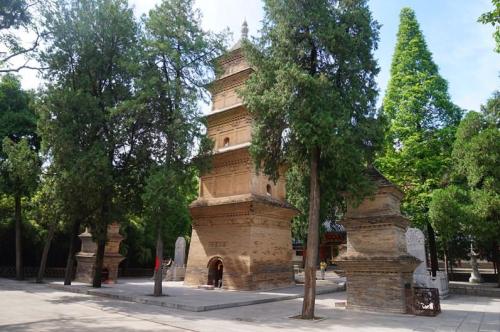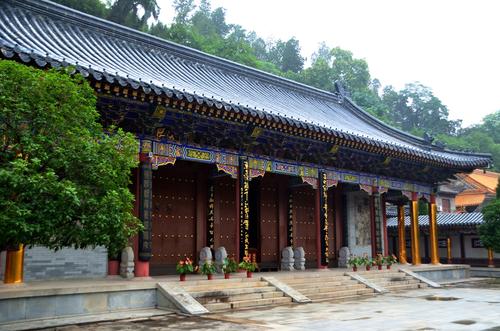Chinese Name: 兴教寺 Pronunciation: Xīngjiào Sì
Building Time: 669
Admission Ticket Fee: Free
Opening Hours: 8:00-17:00
Recommended Time for Visit: 1-2 Hours
Occupied Area: About 20,000 square meters
Address: Shaoling Plain, Chang’an District, Xi’an City, Shaanxi Province, China
Function: Bury and memorize Monk Xuanzang (602-664), a famous translator and traveler in the Tang Dynasty (618-907).

Xingjiao Temple, located at Shaoling Plain, Chang’an District, 20 kilometers south of Xi’an City, was built to bury and memorize Monk Xuanzang, a famous translator and traveler in the Tang Dynasty. Its full Chinese name is “Datang Huguo Xingjiao Si” (The National Guardian and Flourishing Buddhism Temple of Great Tang), implying the great prosperity of Buddhism in the Tang Dynasty.
The temple currently consists of three parts, the halls, the Buddhist Texts Library, and the pagoda courtyard. Among the buildings, Xingjiao Temple Pagoda is the most renowned one, including Xuanzang Dagoba, Kuiji Dagoba, and Yuance Dagoba, which are the dagobas of Xuanzang and his two disciples Kuiji and Yuance.
In 1961, Xingjiao Temple was listed as the Key State Protected Historic Site. In 2014, the temple was included in the World Heritage List.
In 664, Xuanzang died and was buried in White Deer Plain.
In 669, Empress Wu Zetian (624-705), the first and only empress in the history of China, ordered to move the remains of Xuanzang to Shaoling Plain and to build a temple to bury and memorize Xuanzang.
Between 1856 and 1875, all buildings inside the Xingjiao Temple were ruined by wars except the three dagobas.
In 1932, the ruined Xingjiao Temple was restored.
In 1949, the foundation of the Xingjiao Temple sank, seriously endangering the three dagobas.
In the spring of 1953, as Chinese Premier Zhou Enlai accompanied the Indian Prime Minister Jawaharlal Nehru to visit the Xingjiao Temple, the government renovated the temple.
Abbot Changming (1918-2009) was born in Xianyang City, Shaanxi Province in 1918. In 1937, he became a disciple of a prestigious monk in the Zhongnan Mountains. For a couple of years ever since then, Changming read many Buddhist classics and visited many places, which was also the reason why he had a profound understanding and attainment of Buddhism. During 1956 and 1958, Changming studied at the Buddhist Academy of China. After graduation, Changming was invited to Xingjiao Temple by the government and then became the abbot of Xingjiao Temple in 1984.
In 1990, Abbot Kuanchi became a monk of the Xingjiao Temple. In 1996, he became the deputy abbot of the temple. In 2009, Kuanchi was officially appointed as the abbot. Meanwhile, he was also the deputy secretary-general of the Buddhist Association of Shaanxi Province and the vice president of the Buddhist Association of Xi’an.

There are altogether three dagobas in Xingjiao Temple: Xuanzang Dagoba, Kuiji Dagoba, and Yuance Dagoba. Among the three, Xuanzang Dagoba is the highest one standing in the middle with a solemn and stable shape and simple decoration. It is 21 meters high with five floors.
The whole body of the dagoba is built with bricks and in the shape of a quadrangle cone. Xuanzang Dagoba is one of the earliest extant brick pagodas with its outside structure imitating wood structures. It occupies a rather significant position in the history of Chinese architecture.

The Main Hall is a core building of the temple, where monks sit in meditation. The door frame of the hall is decorated with a plaque written by Zhao Puchu, the former vice-chairman of the Chinese People’s Political Consultative Conference (CPPCC). Inside the hall, a gold-plated seated statue of Sakyamuni made in the Yuan Dynasty (1271-1368) is enshrined, which is about 3 meters high and weighs 1.36 tons. There are also a bronze Amitabha statue of the Ming Dynasty (1368-1644), and a white jade statue of Maitreya Buddha from Burma.
On the west side of the hall, there is a bronze statue of Avalokitesvara (Guanyin) of the Tang Dynasty. On the east, there is a wood carved statue of Ksitigarbha of the Ming Dynasty (1368-1644). The whole hall is painted with colorful murals.
It is said that after returning from India, Xuanzang devoted himself to the translation of Buddhist scriptures in the Ci’en Temple in Chang’an (capital city of Tang Dynasty). Although he worked day and night, it was still impossible for him to translate all scriptures. So, he decided to find someone interested in Buddhist studies to carry on his career.
One day, when walking along the street, Xuanzang came across a talented boy. After talking with the boy, he found that the boy had a unique perspective on everything. Thus, Xuanzang decided to take him as a disciple.
The boy was rewarded with the Buddhist name of Kuiji by Emperor Taizong of the Tang Dynasty. Kuiji was not only clever but also industrious. He then became a right-hand assistant of Xuanzang in translating the Buddhist scriptures. He was one of the two greatest disciples of Xuanzang. After Kuiji died, people built a dagoba in the Xingjiao Temple to memorize him.
Enter from the North Gate of the Xingjiao Temple → Bell and Drum Towers → the Main Hall →the Buddhist Texts Library → Stupa Courtyard → Xuanzang Dagoba → Exit from the North Gate
1. Do not wear vests, shorts, and slippers.
2. Do not make noise and interference during religious activities.
3. Do not bring meat and fish products into the temple.
Take bus 735 and get off at Xingjiao Temple Station. You need to walk northward along Xingjiao Temple Road for about 500 meters.
Chinese: 请带我去兴教寺。 English: Please take me to the Xingjiao Temple.
Chinese: 请带我去兴教寺的北门。 English: Please take me to the North Gate of the Xingjiao Temple.
If you go to the Xingjiao Temple from the center of Xi’an (Crowne Plaza Hotel), it takes about 45 minutes (about 70 yuan).
If you go to the Xingjiao Temple from Xi’an Xianyang International Airport, it takes about 110 minutes (about 220 yuan).
If you go to the Xingjiao Temple from Xi’an North Railway Station, it takes about 60 minutes (about 190 yuan).
If you go to the Xingjiao Temple from Xi’an Railway Station, it takes about 50 minutes (about 105 yuan).
